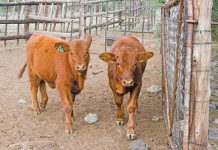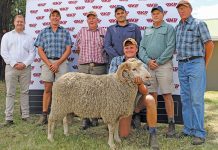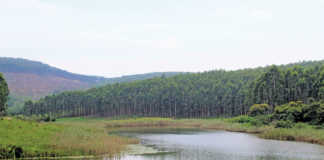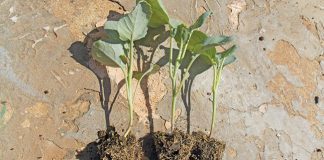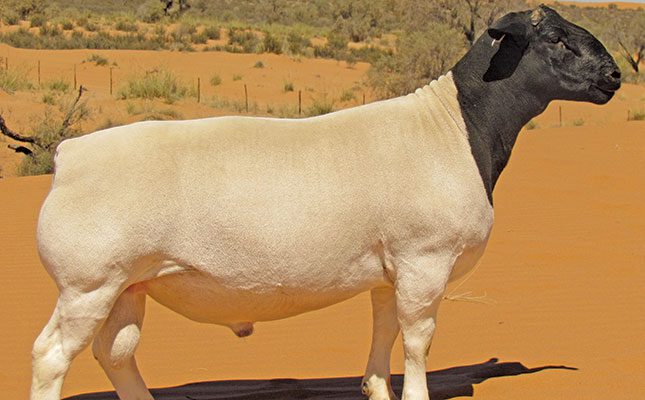
Photo: FW Archive
In South Africa, sheep are farmed for meat or wool – sometimes both. In this article, we look at sheep that are specifically bred for meat and wool, as well as dual-purpose breeds produced for their wool, meat and milk.
Meat breeds
Dorper
The Dorper sheep is an excellent breed for meat and leather, and was developed in South Africa and bred through the crossbreeding of the Dorset Horn and the Blackhead Persian sheep. Van Rooy sheep may also have been used in its development.
The Dorper, recognisable by its black head, was developed in the 1930s by the then Department of Agriculture, with the aim of creating a hardy, fast-growing meat breed that was suitable for production conditions throughout South Africa.
The Dorper Breeders’ Association (now known as the Dorper Sheep Breeders’ Society of South Africa) was established in 1950. Today, the Dorper is produced in countries around the world.
The breed is well suited to dry and extensive production conditions in South Africa. It is known for high fertility, good maternal instinct, high growth rates, and hardiness.
According to the Government of Western Australia’s Department of Primary Industries and Regional Development, Dorper lambing percentages in South Africa of 150% are not uncommon; neither is an average fecundity of 160%. Rams reach sexual maturity at an early age, and can begin covering ewes from as early as five months old. Lambs can be slaughter-ready by four months of age.
The Dorper has short, light wool, and requires no or minimal shearing, making it easy to maintain, particularly under extensive conditions. It is a non-selective grazer, which means that it can be used to graze pasture or veld that other livestock might not want to, and produce high-quality meat with good fat disposition.
It also has thick skin, offering the breed good protection against unfavourable weather conditions, and is sought-after by the leather industry.
The breed is medium-sized and well-muscled. It is also known for its good temperament and easy handling. Dorpers do not need crutching or mulesing, and are far less prone to flystrike than some other breeds.
Blackhead Persian
The Blackhead Persian, used in the development of the Dorper, originated in Somalia, according to various sources, and was imported into South Africa in the 1870s.
It is a fat-tailed sheep that is covered with hair, not wool, thus it copes quite well in hot temperatures. It is naturally polled and has a similar appearance to goats, with long, drooping ears.
The Blackhead Persian is known for its mothering ability and even temperament. Like the Dorper, it is bred for its meat, but its skin is of high-enough quality for the manufacturing of leather. It has a white body, and a black head and neck.
The Blackhead Persian is used all over the world, especially in crossbreeding programmes. Due to its adaptability, heat tolerance and low-maintenance quality, it can be run under most conditions, including those that are arid and extensive.
Initially, the Blackhead Persian was bred for the large quantity of fat stored in its tail region, which made it resilient in arid conditions and was prized for cooking, according to the Food and Agriculture Organization of the United Nations.
It is highly fertile and a prolific breeder. Lambs mature early and can reach slaughtering weight by three or four months, with adult rams and ewes reaching weights of up to 68kg and 52kg respectively. Ewes produce a large volume of good-quality milk, which allows them to raise strong, healthy lambs.
While the Blackhead Persian thrives in arid and semi-arid areas, cold weather may be a hindrance for the breed. It shows remarkable resistance against diseases such as bluetongue, heartwater and pulpy kidney, as well as parasites. It is also drought resistant.
Van Rooy
The Van Rooy sheep was developed in South Africa in 1906 as a cross between the Ronderib Afrikaner and the Rambouillet. Like the Blackhead Persian, it is a fat-tailed sheep covered in hair as opposed to wool, which means there is no need to shear or crutch the breed. Thus, the sheep is easy to maintain and is well suited to arid and extensive conditions.
The Van Rooy is naturally polled, is entirely white, and has drooping ears. It is bred in South Africa and Namibia, and Van Rooy embryos have been exported to Australia for the use in White Dorper crossbreeding programmes there.
The Van Rooy was also used in the development of the Australian White breed, according to the Australian White Sheep Breeders’ Association.
Rams can reach a live weight of anything from 90kg to 120kg. The breed is known for its high fertility and ability to thrive under dry conditions. The latter is largely due to its fatty tail.
It is a medium-sized breed, and has a prominent chest with a characteristic dewlap. Fat distribution is localised in its rump and tail.
Its thick skin, which can also be used to produce leather, gives it great resistance to parasites.
Since ewes produce sufficient milk in hot and dry weather, lambs can be raised under harsh conditions. They also show a fast growth rate.
The breed exhibits early fat accumulation and is often used in crossbreeding programmes. Van Rooy ewes can be mated throughout the year and are ideally suited for accelerated lambing systems.
Meatmaster
Despite being a fairly ‘new’ breed, the Meatmaster, developed in South Africa in the 1990s, has become a very popular meat breed in the country. It was developed by crossing the Damara, Dorper, Van Rooy and Ile de France breeds.
The development of the Meatmaster was aimed at the creation of a breed that had the benefits of a fat-tailed breed, such as resistance to drought and parasites, without some of the disadvantages, which may include poor fat distribution and muscle development.
The Meatmaster was registered as a breed in 2007, and the Meatmaster Sheep Breeders’ Society was formally recognised a year later.
The Meatmaster is a non-fat-tailed, medium-sized breed. It is covered in short hair of various colours, and has a woolly undercoat. Lambs are ready for slaughter by five months of age, when they have reached 38kg. The 100-day weaning weight is 27kg. Rams reach weights of up to 105kg, and both ewes and rams may be polled or horned.
The breed is hardy and fertile, and is suitable for extensive and semi-extensive breeding and veld-grazing systems. Ewes are known for their excellent mothering abilities. As it is a hair breed, it doesn’t need to be sheared, which means it requires less maintenance than meat breeds that have wool.
Meatmasters have been exported to Namibia, Australia and Canada.
Dormer
The Dormer, a white-wool breed, was developed in South Africa in 1927 by crossbreeding Dorset Horn rams with German Merino ewes. Its development was aimed at producing rams that could be used in crossbreeding programmes, and slaughter lambs that could grow out rapidly and economically in the cold and wet winter rainfall areas of South Africa.
The Dormer Sheep Breeders’ Society of South Africa was established in 1965.
While initially bred to produce slaughter lambs in the Western and Southern Cape, the Dormer is now found throughout South Africa, with most breeders located in the Free State and Gauteng.
The Dormer can be run under both extensive and intensive conditions, and is known to thrive in feedlots. The breed produces lambs that are market-ready at an early age, and shows a good feed conversion ratio.
It is highly fertile and, since lambs have low birth weights, ewes experience few lambing problems. Ewes show good maternal ability, and a high propensity for the production of multiples. The breed is particularly suitable for crossbreeding programmes. They are also non-selective grazers, which make them ideal for diversified operations.
Rams reach live weights of between 110kg and 130kg. An average lambing percentage of 120% to 150% is achieved. The breed is naturally polled, and produces completely white, kemp-free wool of around 27 microns. As such, it can be crossbred with wool breeds.
Wool breeds
Merino
The Merino is a breed characterised by very fine, soft wool of less than 24 microns. It was established in Spain towards the end of the Middle Ages, and was kept as a strict Spanish monopoly for several centuries; reportedly, exports of the breed weren’t allowed, and those who tried to export the sheep could face the death penalty.
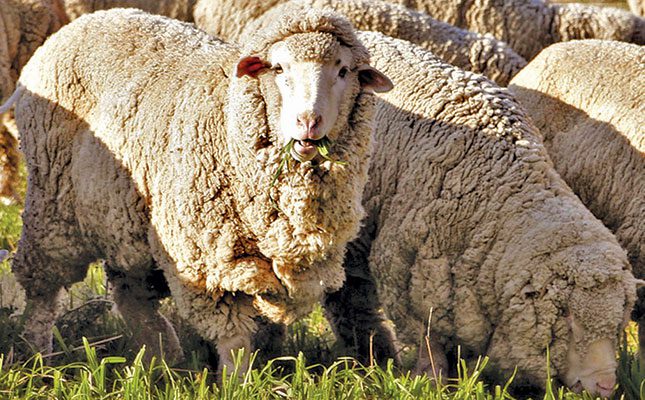
During the eighteenth century, flocks were sent to the courts of a number of European countries, including France (where they developed into the Rambouillet), Hungary, the Netherlands, Prussia, Saxony, Estonia, Livonia and Sweden.
The Merino is highly adaptable and an excellent forager. However, as it is a wool breed, it needs regular shearing. The breed’s wool doesn’t stop growing, thus neglecting the shearing thereof can lead to heat stress and mobility issues.
While it is fine, Merino wool can be characterised under wool categories, including strong (23 to 24 microns), medium (23 to 24,5 microns), fine (18,6 to 20,9 microns), superfine (15 to 18,5 microns) and ultra-fine (11,5 to 15 microns).
Merinos generally have calm temperaments and are known to get along with other animals on the farm. They are medium-sized sheep and reach mature weights of around 55kg.
They are hardy and adaptable, and show excellent mother ability. While it is mostly produced for wool, the Merino can also be used for meat.
Dual-purpose breeds
Ile de France
The Ile de France sheep is native to the French region of Île-de-France near Paris. It was developed at a French veterinary college in 1822, and was originally a cross between the Dishley Leicester and Rambouillet sheep breeds.
The breed was imported into South Africa in 1903, but commercial breeding in the country only began in 1972. The Ile de France Breeding Society of South Africa was established in 1980.
The breed is highly adaptable and can thrive under intensive, semi-intensive and extensive conditions. It is a large breed, with rams reaching weights of as much as 145kg.
The Ile de France is known for its maternal abilities and high-quality meat. It is a large, smooth-bodied and naturally polled breed that produces strong white wool of between 23 and 27 microns.
According to some sources, the breed is mostly used for meat, but its wool can also be used to generate further income from the breed. In France, it is also used for milk, and it is registered as a milk breed in the US.
It is also used in crossbreeding programmes, with rams known to produce early maturing lambs. Rams are also used as terminal sires in crossbreeding programmes, passing on exceptional conformation, muscle development and a fast growth rate to its progeny. When crossed with a Merino, progeny can produce outstanding medium wool.
Ewes experience few lambing problems due to the low birth weights of lambs. Lambing percentages are, on average, between 150% and 170%.
The Ile de France lamb has excellent growth abilities and can achieve weights of between 19kg and 22kg at 42 days, and between 34kg and 41kg at 100 days. Slaughter lambs are ready for market from as early as 100 days.
The breed’s meat isn’t excessively fatty, and the carcass shows outstanding muscle development, according to the Ile de France Breeding Society of South Africa.
South African Mutton Merino
The South African Meat Merino (SAMM) is a wool and meat sheep breed developed in South Africa, but is found throughout the world.
It was derived from the German Merinofleischschaf breed, which was imported into South African in 1932 to improve the quality of wool and meat from sheep here. It was officially recognised as a breed in 1971.
It is a very versatile and hardy breed that is naturally polled. Ewes have good maternal ability and produce large volumes of milk. The breed is considered large, with rams reaching mature weights of up to 100kg.
Lambs are early maturing, reaching weights of 35kg by 100 days. The breed is highly fertile, with a propensity to produce multiples. It also shows early sexual maturity, and is very adaptable, making it ideal for intensive and extensive conditions in high- and low-rainfall areas.
The breed is also suitable for feedlots due to its excellent feed conversion ratios. It shows good resistance to Johne’s disease and wireworm. It is a non-selective grazer.
The SAMM produces medium-strong wool. The ewes produce an average of 3,4kg of kemp-free wool of 18 to 25 microns.
Dohne Merino
The Dohne Merino was developed in South Africa in the 1930s by interbreeding Peppin-style Merino ewes and German Mutton Merino rams. It is as a dual-purpose breed used for its meat and wool.
The Dohne Merino is a medium-framed breed, and rams reach weights of between 80kg and 100kg. Yearly fleece production is 3,5kg to 5kg, with wool fibres of an average diameter of 17 to 21 microns.
Since the breed’s development over 80 years ago, Dohne Merino embryos have been exported to establish breeder societies in Australia and Uruguay.
The breed is polled, white and produces fine to medium wool. Lambs achieve slaughter weight at around four to six months of age. The breed is docile and easy to handle, and it thrives in semi-intensive conditions.

